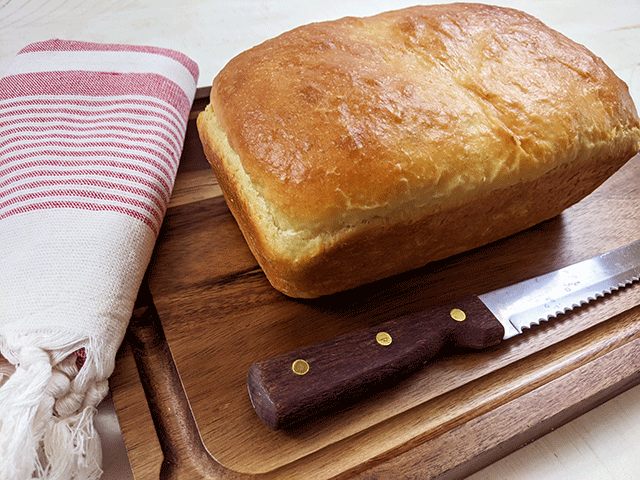
In a rush? You can skip straight to the Satin Smooth Sourdough Sandwich Bread recipe at my Tumblr or you can jump to my Just to the Basics section.
I love revisiting old favorite recipes and giving them a bit of a new twist. My husband actually recommended that I revisit my old cinnamon swirl raisin sourdough bread recipe because he loved the texture and the flavor.
So here we are again, making more sourdough bread. But this time, it’s super soft, light, and with the barest hint of sourdough tang.
I call it Satin Smooth and Soft Sourdough Sandwich bread. Because, you know, alliteration is great.
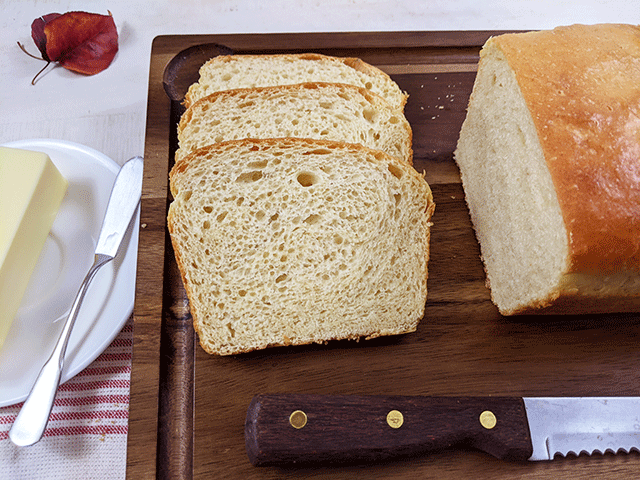
This recipe revisit couldn’t have gone any better. I scrapped the cinnamon swirl. Dropped the raisins. Kept the sourdough starter, and upgraded my flour from all-purpose to bread flour.
And behold: bread so soft and airy that it’s like cutting into a cloud. Seriously, my knife meets almost no resistance, and if I’m not careful, my fingers could easily punch a hole in the crust.
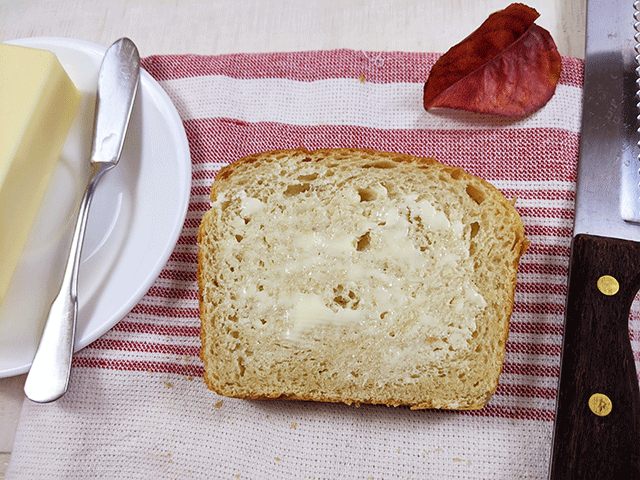
This is such beautiful sourdough sandwich bread that I almost feel guilty cutting into it. It’s perfect for toasting. And it’s tasty just how it is. No butter or jam needed (though I’ve had it with both, too).
I could eat the whole loaf on my own.
Time
Prep time: 10-15 Minutes
Rise time: 3 to 4 Hours
Cook time: 40 to 45 Minutes
Total time: Approximately 4 hours 5 minutes to 5 hours 15 minutes
Ingredients
Here’s what you’ll need to make this super soft sourdough sandwich bread:
- 9 Grams (2 1/2 Teaspoons) Dry Active Yeast*
- 152 Grams (2/3 Cup) Warm Water
- 113 Grams (1/2 Cup) Sourdough Starter
- 7 Grams (1 1/4 Teaspoons) Salt
- 12.5 Grams (1 Tablespoon) White Granulated Sugar
- 71 Grams (5 Tablespoons) Butter
- 1 Large Egg
- 361 Grams (2 1/2 Cups to 3 cups) All-Purpose Flour or Bread Flour*
*You can also use instant yeast and skip the proofing process.
**I’ve tried this recipe with both flours. If you use bread flour, your loaf will hold its shape a little better and have a slightly chewier texture.
If you don’t have bread flour, you can mix vital wheat gluten and all-purpose flour with the following measurements:
- 346 Grams (Cups) All-Purpose Flour
- 15 Grams (Teaspoons) Vital Wheat Gluten
Can’t find vital wheat gluten at Walmart or your usual grocery store? You can order vital wheat gluten from Amazon. As am Amazon associate, I do earn a small commission for affiliate links, but I only recommend products I regularly use and enjoy.
Additional Equipment
Here are a few kitchen basics for making sourdough sandwich bread:
- Standing Mixer*
- Measuring Cups and Spoons
- Large Mixing Bowl
- Dough Chopper/Pastry Cutter
- 9″x 5″ Loaf Pan
- Wire Cooling Rack
*You can mix the dough by hand if you wish. It just takes a little longer to knead everything together.
You don’t have to purchase any of the above items. I simply recommend products that I regularly use and enjoy, though I do receive a small commission for affiliate links.
Instructions
This soft sourdough sandwich bread uses sourdough discard – so you don’t have to worry about about feeding your starter before hand. Although a bubbly starter contributes to fluffy bread, this recipe uses commercial yeast to do the hard work and relies on sourdough starter for flavor.
Mix Your Dough
Because yeast does the work, you’ll want to proof your yeast before mixing it with the rest of your dough. To start, combine the warm water with your yeast and stir it around in the bowl of your standing mixer. Let it sit 10 to 15 minutes until bubbly.
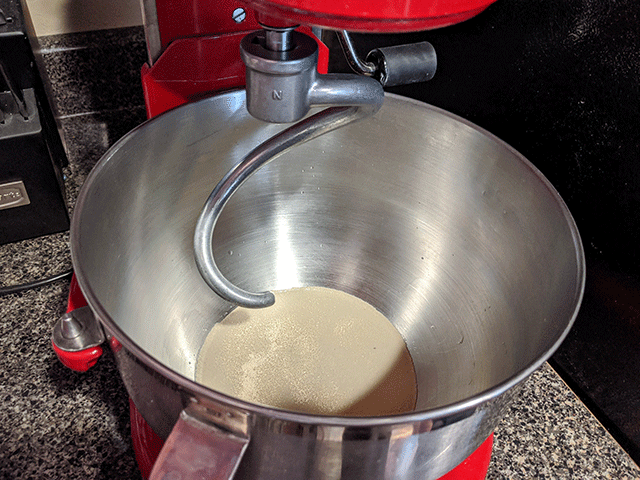
Next, add your sourdough starter. Stir it around and give it a chance to settle, about 5 to 10 minutes.
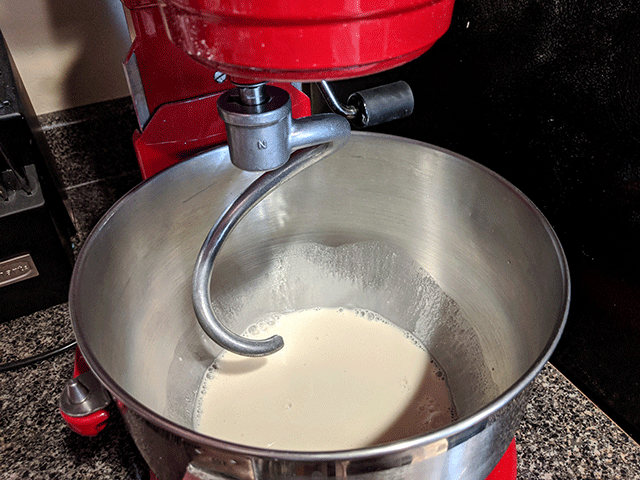
Next, add your salt, sugar, butter, egg, and half of the flour to the mix. Mix on low and slowly add the rest of the flour 1/2 cup at a time. Depending on the consistency of your starter, you may have to adjust your measurements a little, so go slow and keep an eye on your dough.
Continue to mix until you have a soft, smooth, elastic dough that pulls away from the sides of bowl. The dough should feel slightly tacky to the touch, but not sticky. If your dough feels sticky and doesn’t hold its shape, add a little more flour.
Turn your dough out onto a lightly floured surface and knead it a little. Shape the dough into a round.

Let It Rise
Transfer the round to a lightly greased bowl. I prefer a container with a lid and measurements on the side so my dough can stay soft and so I can see just how much my dough rises.
Let dough rise until it has doubled in size. Depending on the ambient temperature of your kitchen, you may need anywhere from 1 1/2 hours to 2 hours.
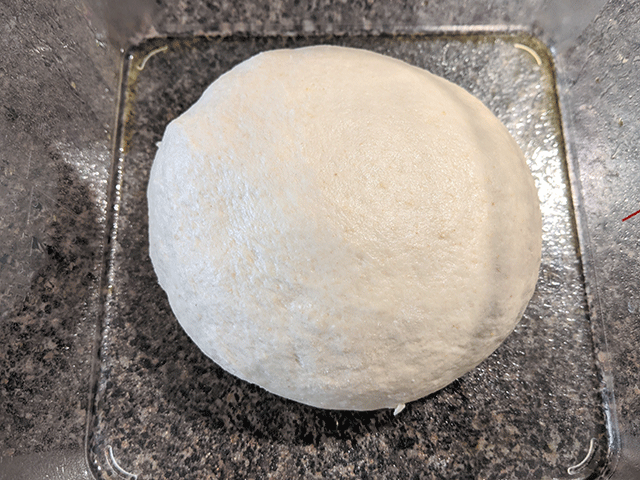
After it has doubled, punch it down and turn out your dough onto a lightly greased surface. Reshape into a round, cover, and let rest for 15 minutes.
Shape Your Loaf
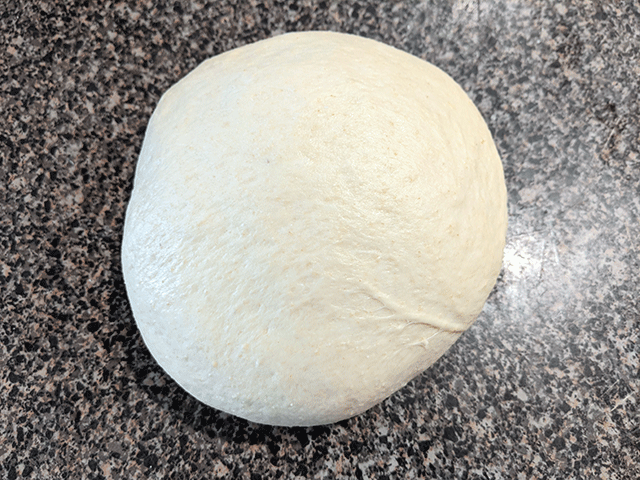
Use your fingers to dimple the dough and to loosely shape a rectangle. You want to make a rectangle a little bigger than your baking pan, but don’t worry about making it perfect since you will be folding it.
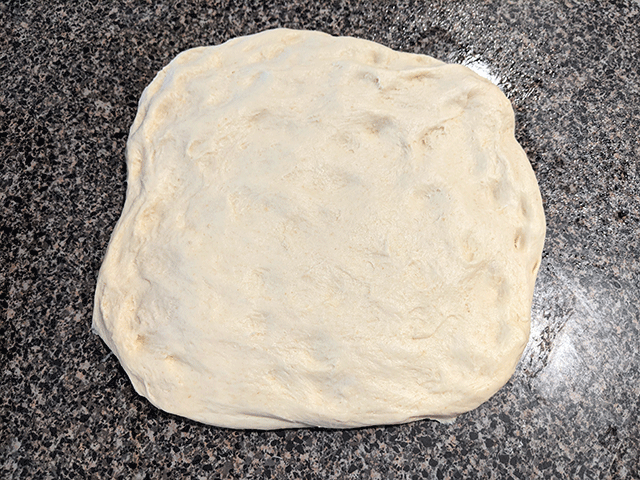
Gently stretch and fold the dough down (hot-dog style, if it helps) about two-thirds the length of your rectangle.
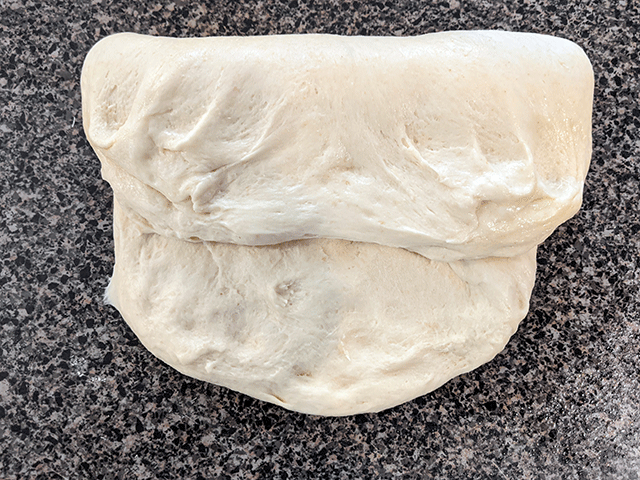
Gently stretch and fold the bottom third of your dough up. Your dough should look kind of like a lumpy burrito at this point.
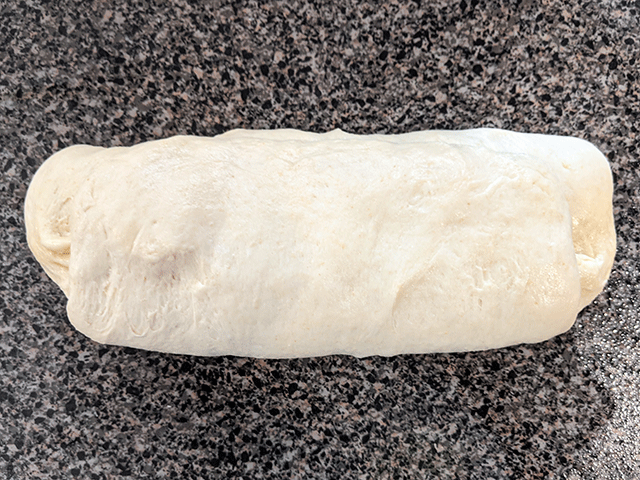
Then fold the edges toward the middle. Make sure you fold in the edges enough so your loaf will fit in your baking pan at this point.
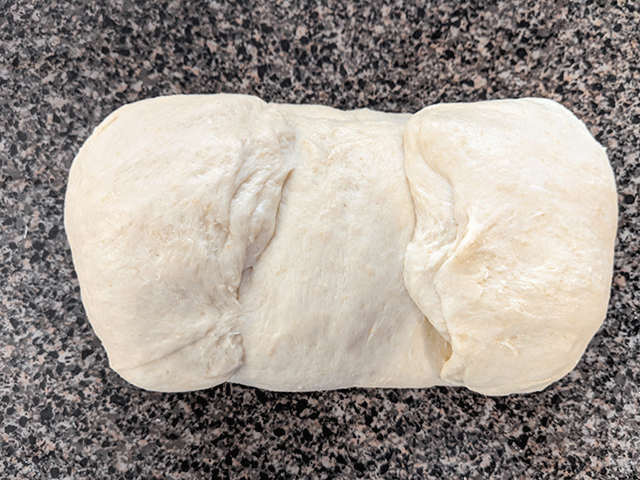
Flip the dough over so the seams are face down on your surface. Use your hands to cup one length of the dough and pull it slightly toward you so the surface of the dough becomes taught (but try not to break it).
Repeat with the opposite side, cover, and let rest for 10 minutes.
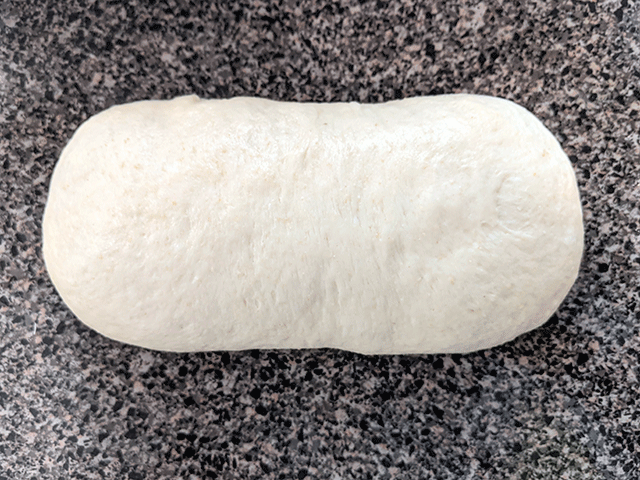
When you’re ready, use a dough chopper to slide under your dough and transfer it to your lightly greased baking pan. If some of your edges didn’t quite slide in as you had hoped, lightly grease your chopper and use it to gently push down the edges of your dough.
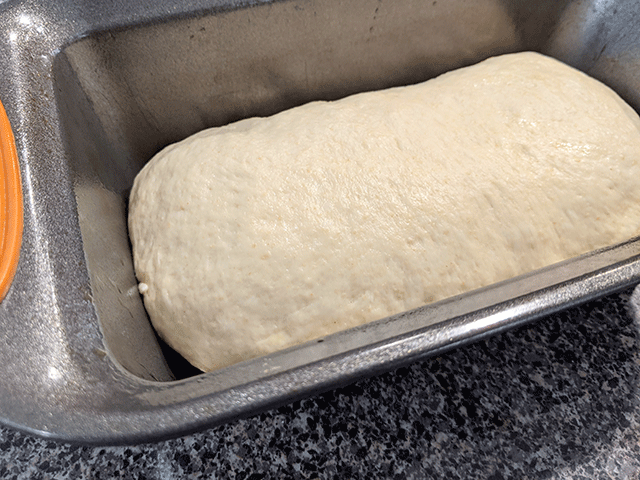
Let It Rise Again
Cover and let your dough rise until it has risen above the edge of the pan, about 1 hour to 1 hour 30 minutes depending on your kitchen temperature.
Not sure if your dough has risen enough? Lightly poke it. If the dough springs back quickly, it could use more time. If the dough rises back slowly, it’s ready to bake. Dough that collapses has risen too long but you can still bake it anyway.
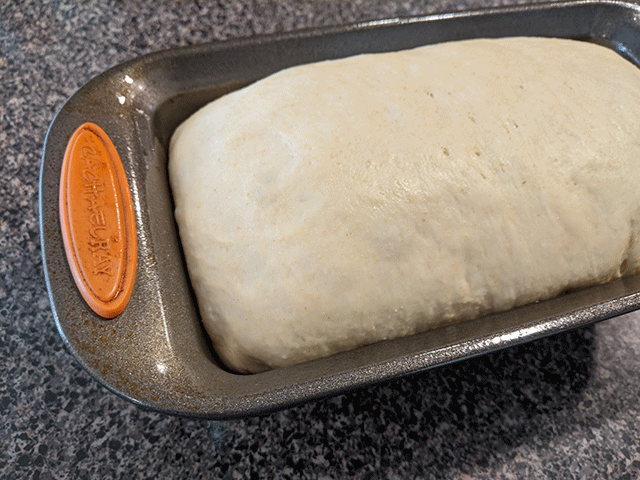
Bake Your Bread
Preheat your oven to 350 degrees Fahrenheit (176 degrees Celsius) and bake for 20 minutes.
Take your bread out and tent it with aluminum foil to keep your crust from browning too much. Bake for an additional 20 to 30 minutes.
Not sure if your loaf is done? Use a kitchen thermometer. It should read between 190 and 200 degrees Fahrenheit (87 and 93 degrees Celsius). Or, lightly thump the bottom of your bread. It should sound hollow. Just don’t thump your bread too hard – it’s pretty soft and delicate.
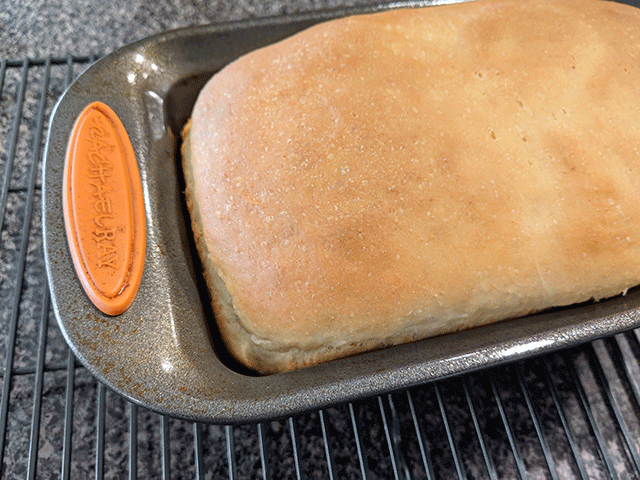
Turn your sourdough sandwich bread out onto a wire cooling rack and brush it with melted butter. The butter will soften your crust and give it a richer color.
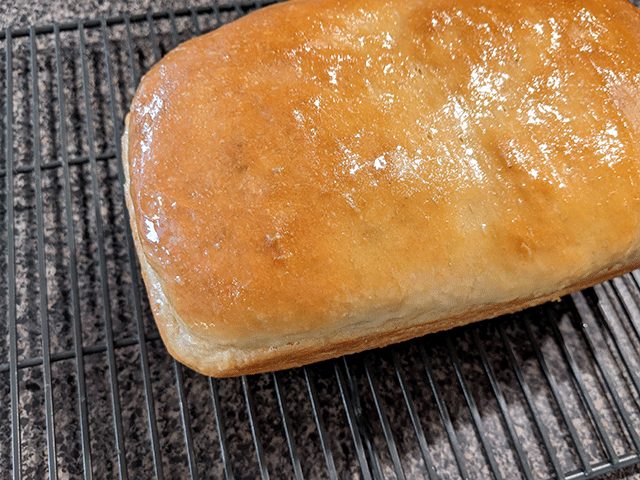
Let your loaf cool completely on the rack before cutting into it. The residual heat will finish baking your loaf.
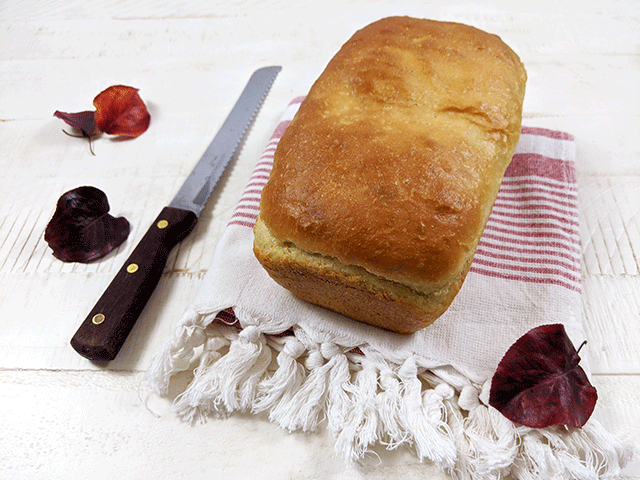
Slice and enjoy!
This soft sourdough sandwich bread will stay delicious for several days if you keep it in a bag at room temperature. However, it tastes best the same day it is baked.
Just the Basics

Satin Smooth Sourdough Sandwich Bread
Ingredients
- 9 Grams Dry Active Yeast (2 1/2 Teaspoons)
- 152 Grams Warm Water (2/3 Cup)
- 113 Grams Sourdough Starter – Fed, Unfed, or Discard (1/2 Cup)
- 7 Grams Fine Sea Salt (1 1/4 Teaspoon)
- 12.5 Grams White Granulated Sugar (1 Tablespoon)
- 71 Grams Butter – Melted (5 Tablespoons)
- 1 Large Egg
- 361 Grams All-Purpose Flour (2 1/2 Cups)
Instructions
- To start, combine the warm water with your yeast and stir it around in the bowl of your standing mixer. Let it sit 10 to 15 minutes until bubbly.
- Add your sourdough starter. Stir it around and give it a chance to settle, about 5 to 10 minutes.
- Add your salt, sugar, butter, egg, and half of the flour to the mix. Mix on low and slowly add the rest of the flour 1/2 cup at a time.
- Continue to mix until you have a soft, smooth, elastic dough that pulls away from the sides of bowl.
- Turn your dough out onto a lightly floured surface and knead it a little. Shape the dough into a round.
- Transfer the round to a lightly greased bowl. Let dough rise until it has doubled in size, 1 1/2 hours to 2 hours.
- After it has doubled, punch it down and turn out your dough onto a lightly greased surface. Reshape into a round, cover, and let rest for 15 minutes.
- Use your fingers to dimple the dough and to loosely shape a rectangle.
- Fold the rectangle into a sandwich loaf and let rest for 10 minutes.
- Transfer the dough to a lightly greased bread pan and let rise until it has crested the edge of the pan, about 1 hour to 1 1/2 hours.
- Preheat your oven to 350° Fahrenheit (176° Celsius) and bake your bread for 20 minutes.
- Take your bread out and tent it with aluminum foil to keep your crust from browning too much. Bake for an additional 20 to 30 minutes. The internal temperature should read between 190° and 200° Fahrenheit (87° and 93° Celsius).
- Turn your bread out onto a wire cooling rack and brush it with melted butter. Let bread cool completely before slicing and serving.
Notes
Secrets to Success
I didn’t have many issues making this sourdough sandwich bread. Because of the commercial yeast, it rises beautifully and bakes wonderfully.
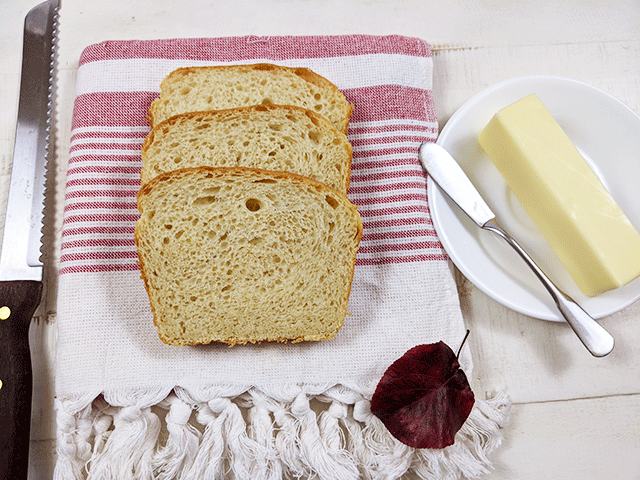
However, the hardest part about making this recipe is simply shaping a sandwich loaf. I did my best to show you the easiest way to shape a sandwich loaf, but it’s still a challenge to get that perfect fold.
The only suggestion I have here is to practice shaping your loaf next to your baking pan so you get a good size. You might have to make the recipe a few times before you get a loaf that looks just right.
But even if your loaf looks a little lop-sided, it will still taste yummy.
Nutritional Information
Here’s a look at the nutritional content for my Satin Smooth and Soft Sourdough Sandwich Bread:
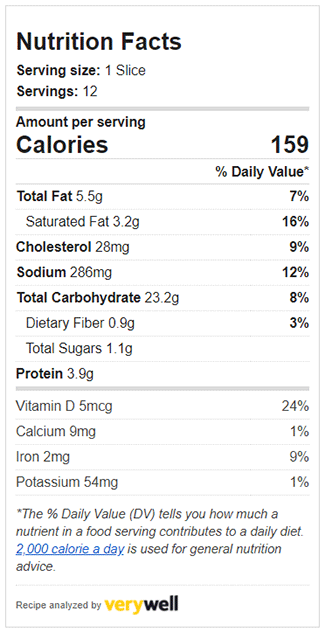
Keep in mind that I cut my loaf into about 12 slices. This sourdough sandwich bread can slice even thinner, but it’s so light and airy that I like to keep my pieces thicker so I can taste the bread. If you cut thinner or thicker pieces, your calorie count will vary.
Did You Try It?
I love making this recipe – and it’s probably going to be my go-to sourdough sandwich bread recipe for the foreseeable future. But what do you think about this recipe? Did you have fun making it? Where did you struggle? What would you do differently?
Share your thoughts and comments below!

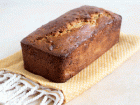

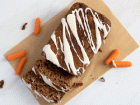
This was my very first bread with my very first sourdough started. It was so easy and turned out perfectly!!!
Thank you so much for this recipe:)
I’m so happy to hear that! You are so welcome, and thank you so much for your feedback. Happy baking 🙂
Don’t understand taking bread OUT and tenting with alum foil? Can’t you tent while still in oven? Why take out of oven? You don’t mean take out of pan do you????
Sorry for the confusion Linda. You can leave the bread in while you tent it. Personally I’m just a bit clumsy and I’m more likely to get burnt if I fuss with bread while it’s in the oven. Also, the longer the oven door is left open, the more heat is lost, which affects how long I bake for. It’s easier for me if I just put the bread still in the pan on my stovetop while I tent it, then pop everything back in.